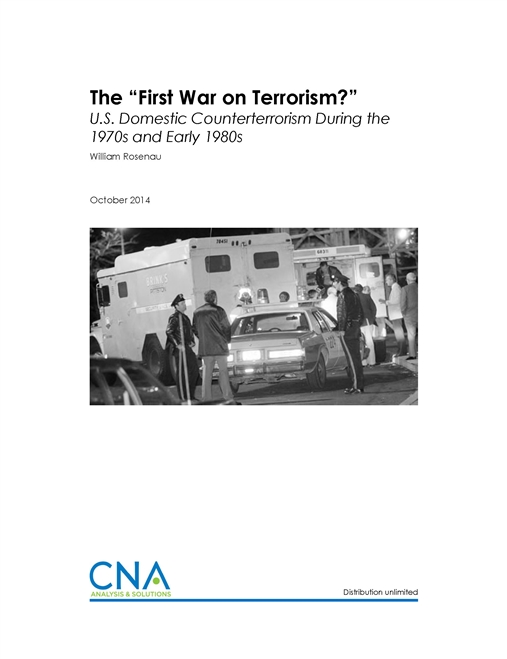Combating terrorism at home and abroad has been at the top of the U.S. policy agenda since September 11, 2001, when al Qaeda terrorists killed nearly 3,000 people in New York, Virginia, and Pennsylvania. But the history of counterterrorism in the United States has received relatively little analytical attention. Contemporary policy debates would benefit from the perspectives that historical analysis can provide.
This paper examines the forgotten history of counterterrorism in the United States during the 1970s and early 1980s. That period was part of a long wave of terrorism that occurred across the developed world. Within the United States during that period, terrorist groups—including ethno-nationalists, separatists, and Marxist- Leninists—conducted a remarkable number of attacks, some of which resulted in significant injuries and deaths.
But numbers alone do not capture the violent intensity of the period’s terrorism. The terrorists’ violent repertoire was astonishing: political kidnappings, the murder of policemen, the ambush of U.S. Navy personnel, the assassination of diplomats, and million-dollar armed robberies. True, there were no “mega-terrorism” incidents on the scale of 9/11 or the April 19, 1995 Oklahoma City bombing that killed 168 people and wounded 680 others. However, as the Federal Bureau of Investigation (FBI) director who served during the 1970s and 1980s later observed, terrorists operating in the United States were “life-threatening, caused loss of life, [and] were considered seriously disruptive.” Events abroad, such as the murder of 11 Israeli athletes by Black September terrorists at the 1972 Munich Olympics, contributed to the growing belief among politicians, journalists, and the public that more effective measures were required to deal with the terrorist threat.
Law enforcement agencies, and, in particular, the FBI, overcame the post-Watergate unease surrounding domestic security and mounted aggressive investigations of suspected terrorists, expanded the use of informants, and built a stronger intelligence base. A number of the structures created during this turbulent period, such as the Joint Terrorism Task Forces (JTTF), remain prominent components of today’s counterterrorism inventory. It is unlikely that these countermeasures alone were responsible for bringing the cycle of terrorism to a close, but they did play a part in helping end a notably violent period in America’s political history.
What does this suggest for current counterterrorism policy? The threat environment obviously has evolved over time, and today, “homegrown” jihadists, “Sovereign Citizens,” and “lone wolves” populate the terror landscape. Social media, and what the director of the National Counterterrorism Center calls the “boundless virtual environment” offers terrorists new ways to recruit members, spread propaganda, and plan operations. Cyberterrorism is a potential new addition to the terrorist arsenal.1 Historical research and analysis can assist decisionmakers as they develop responses to the challenges posed by today’s domestic terrorists. A review of counterterrorism during the 1970-1985 period reveals three interrelated themes that are particularly noteworthy:
- It is possible for a democratic state to prevail against terrorism. Democratic states possess inherent strengths, such as political legitimacy and greater resources relative to even the strongest terrorist groups. During the 1970- 1985 period, the United States demonstrated political, social, and institutional resiliency. Although terrorists (and a few counterterrorists) spoke of incipient revolution, the United States was never in danger of being even seriously weakened, let alone overthrown.
- “War” is not the only way to frame counterterrorism. Despite the intensity of domestic violence, the U.S. government never seriously considered, let alone mounted, anything like the post-9/11 effort against terrorism. This is not to suggest that the United States did nothing—far from it. But the government largely ignored insurrectionary rhetoric and fiery calls for national liberation. Despite the highly ideological nature of the terrorist groups (and the milieus from which they emerged), there was no government attempt to wage a “war of ideas” or explicitly promote a counter-ideology.
- Law enforcement can be at the center of an effective counterterrorism strategy. Most Americans certainly considered terrorism a serious menace. But few people considered it an existential threat requiring stringent new laws, militarization, or the curtailment of civil liberties. Instead, domestic terrorism was conceptualized as a threat to public safety and security that required a law enforcement response. Investigating and prosecuting suspected terrorists lay at the heart of the U.S. approach to countering domestic terrorism during this period.
Finally, the history of counterterrorism in the 1970s and early 1980s suggests that a number of political, organizational, and operational issues are likely to persist. These include the need for cooperation among federal, state, and local police agencies; the balance between civil liberties and security; and the nature of the threat posed by weapons of mass destruction.
Download reportDistribution unlimited.
Details
- Pages: 48
- Document Number: CRM-2014-U-008836
- Publication Date: 10/3/2014
